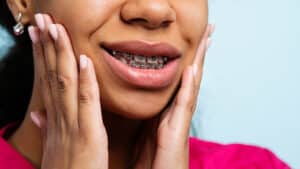Choosing the right braces can make a big difference in achieving a healthy, confident smile. With so many options available, deciding can feel overwhelming. Metal braces and clear aligners both work effectively, but they suit different needs. This guide will help you weigh the pros and cons of each option and find what fits your lifestyle.
Understanding Metal Braces
Metal braces have been around for decades, earning a reputation for being reliable and effective. They consist of metal brackets attached to the teeth, connected by a wire that gradually shifts the teeth into place.
Advantages of Metal Braces
- Durability: Metal braces withstand wear and tear, making them ideal for younger patients or those with significant dental issues.
- Effectiveness: They address even the most severe alignment problems, including overcrowding, gaps, and bite issues.
- No Compliance Needed: Since they’re fixed, patients don’t need to remember to wear them.
- Cost-Effective: Metal braces are often more affordable compared to newer alternatives, making them accessible to more people.
Downsides to Consider
- Appearance: The metallic look might make some people feel self-conscious.
- Diet Restrictions: Patients need to avoid hard or sticky foods.
- Discomfort: Brackets and wires can sometimes irritate the cheeks or gums.
- Longer Adjustment Period: Some patients need time to get used to the feel of braces.
The Appeal of Clear Aligners
Clear aligners are a modern alternative to metal braces. These removable trays are custom-made to fit snugly over the teeth, gradually shifting them into position.
What Makes Clear Aligners Popular
- Discreet Appearance: Aligners are nearly invisible, making them a favorite for adults and teens who prefer a subtle option.
- Removability: Being able to remove aligners makes eating, brushing, and flossing easier.
- Comfort: With no wires or brackets, clear aligners usually cause less irritation.
- Custom Fit: Each set of aligners is tailored to the patient’s teeth for precise adjustments.
Possible Drawbacks
- Discipline Required: Patients must wear aligners for 20-22 hours daily for them to work.
- Cost: Clear aligners often come at a higher price compared to metal braces.
- Limitations: They may not be as effective for severe alignment issues.
- Risk of Loss: Because they are removable, aligners can be misplaced, leading to delays in treatment.
Key Factors to Consider
When deciding between metal braces and clear aligners, it’s essential to assess your lifestyle, budget, and dental needs.
Lifestyle and Aesthetics
If you value appearance, clear aligners might appeal to you more. Their subtle design ensures they don’t draw attention. On the other hand, if you’re not bothered by visible braces, metal ones might be a practical choice. For active individuals or those involved in sports, clear aligners might offer more convenience.
Maintenance and Care
Metal braces require regular adjustments and meticulous cleaning around the brackets. Clear aligners need consistent cleaning and proper storage when not in use. Misplacing aligners can delay progress, so staying organized is essential. Metal braces, while fixed, require patients to adapt to new oral hygiene practices, including using tools like interdental brushes.
Budget
Metal braces tend to be more affordable, making them accessible to a wider range of patients. Clear aligners often cost more, but the price may be worth it for their convenience and appearance. Discuss financing options with your orthodontist to find a plan that fits your budget.
Age
Clear aligners are often preferred by adults and teens because of their discreet nature. Metal braces are suitable for all ages but may appeal more to younger patients who are less concerned about aesthetics.
Comparing Treatment Times
Both options work efficiently, but the timeline varies depending on your specific needs.
- Metal Braces: Typically worn for 18-36 months. They’re effective for a wide range of dental issues. Consistency with orthodontist visits is crucial for timely results.
- Clear Aligners: Treatment usually lasts 12-18 months for mild to moderate cases. More severe cases may require longer. Aligners’ effectiveness depends heavily on patient compliance.
Consulting an Orthodontist
Before making a decision, consulting an orthodontist is crucial. They’ll evaluate your dental health and recommend the best treatment plan. Some factors they consider include:
- Severity of alignment issues.
- Oral hygiene habits.
- Age and lifestyle.
- Willingness to commit to the treatment process.
Orthodontists may also use advanced imaging technology to provide a preview of potential results, which can help you decide.
Myths About Braces and Aligners
Metal Braces Are Only for Kids
While many children use metal braces, they’re just as effective for adults. Age doesn’t limit their effectiveness. Adults often choose them for their reliability and affordability.
Clear Aligners Are Less Effective
Clear aligners can handle a range of dental issues, though they may not work for the most severe cases. Advancements in technology have made them increasingly versatile. In many cases, they can achieve similar results to traditional braces when used correctly.
Braces Are Painful Throughout Treatment
While braces may cause discomfort initially or after adjustments, the sensation typically subsides. Orthodontists often provide tips or products to ease any temporary irritation.
Tips for Success During Treatment
- Follow Instructions: Stick to your orthodontist’s guidelines, especially for clear aligners, to ensure optimal results.
- Practice Good Oral Hygiene: Brush and floss regularly to prevent issues like cavities or gum disease during treatment.
- Attend Regular Appointments: Consistent check-ups allow your orthodontist to monitor progress and make necessary adjustments.
- Stick to a Balanced Diet: Avoid foods that can damage braces or affect your treatment progress.
- Use Recommended Tools: Consider items like water flossers or orthodontic wax to make the process more comfortable.
Final Thoughts
Choosing between metal braces and clear aligners depends on your priorities. Metal braces offer reliability and affordability, while clear aligners provide discretion and convenience. Each option has its strengths and challenges. Understanding their differences and consulting a professional can help you make the right choice for your smile. A healthy, straight smile is worth the effort, regardless of the path you choose.




